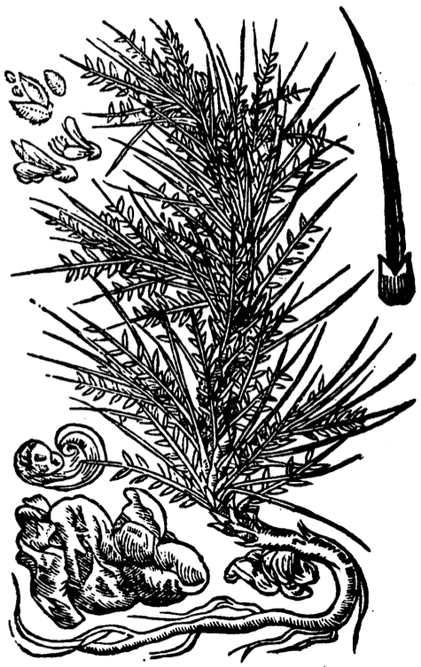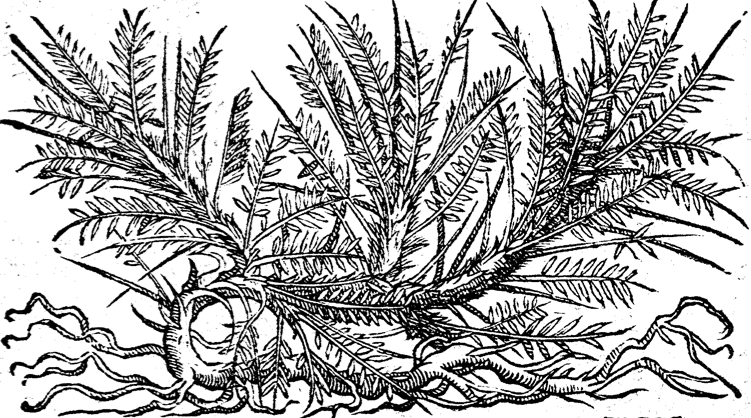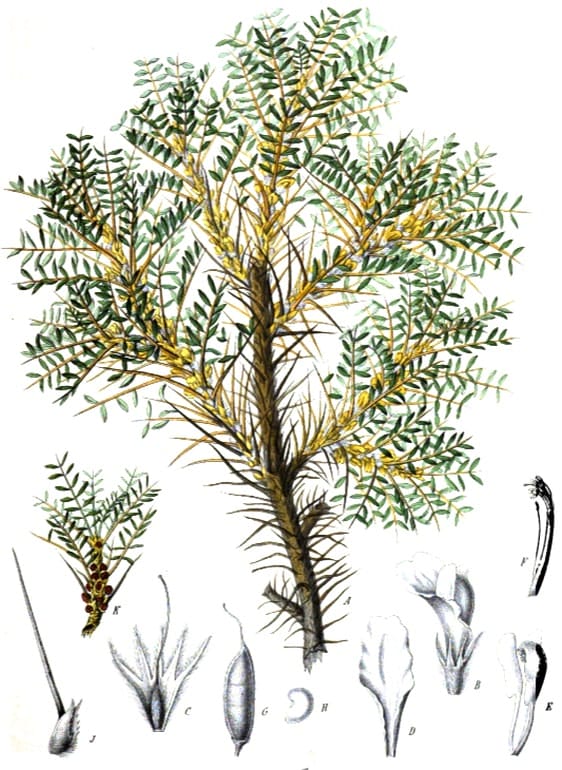Tragacantha, Gum Tragacanth
Kateera, Katira (Unani) Medical Botany, Woodville, Hooker, Vol. 3, 1832
Medical Botany, Woodville, Hooker, Vol. 3, 1832
 Parkinson,
Parkinson, Theatrum Botanicum, 1640 |
 Dioscorides Materia Medica,
Dioscorides Materia Medica, Mathias, 1563 |
 Atlas der officinellen pflanzen (2), Felix, 1899
Atlas der officinellen pflanzen (2), Felix, 1899 Members CLICK HERE for the PRO VERSION
Members CLICK HERE for the PRO VERSIONBotanical name:
Astragalus tragacanth (Asia minor, Perisa), A, gummifer (widely distributed through central Asia)
Parts used:
Gum
Temperature & Taste:
Neutral. Sweet
Classifications:
2E LENITIVE. 2G. CLEANSING. 2O. ASTRINGENT. 2S. STRENGTHENING. 2W. SARCOTICS
3E. DIURETIC. 3F. LITHONTRIPTIC. 3L. ANTI-TUSSIVE
4a. CEPHALIC. 4d. PECTORAL. 4e. STOMACHIC. 4j. NERVINE
Uses:
1. Stops Cough, Strengthens the Lungs:
-tickling Coughs, Hoarseness
-Lung weakness from Qi or Yin deficiency
2. Strengthens Spleen, Benefits Qi:
-in various formulas to nourish and strengthen; good for deficiency and weakness
-lack of energy, poor immunity
-an important corrective for harsh and irritating medicines (Unani)
3. Strengthens the Exterior, Stops Sweating:
-‘stops the pores’ (Salmon)
-sweating from deficiency; spontaneous sweating
-strengthens immunity and protects from infection
4. Clears Heat, Nourishes Yin:
-nourishes Yin of Lungs, Stomach, Bowels and Kidneys
-restores in Consumption, Wasting and after long illness, Hectic Fever
-used for burning sensations of the body
-Nourishes Sperm
5. Clears Heat, Promotes Urine:
-sharp and scanty urine
-Strangury and heat of the urine. (dissolved in Sweet wine)
6. Mucilaginous:
-Very good for making emulsions and mucilage.
-Used for the suspension of insoluble or heavy powders, and to give consistency to Lozenges and Pastilles etc.
7. Promotes Bowel Movement:
-a gentle laxative; used for ‘Gnawing of the Bowels’.
8. Externally:
-Dissolved in milk, it was used as an Eyewash for ‘weals and scabs that grow on the eyelids.’ (Culpeper)
-in plasters and poultices for Wounds, especially of the sinews and nerves. (Culpeper)
-Mucilage of Tragacanth has been used as an external application to burns.
Dose:
Powder: 200mg–1 gram
Correctives:
… available in PRO version
Substitutes:
… available in PRO version

Main Combinations:
Gum Arabic & Tragacanth
1. To nourish Lung Yin, stop Cough, Consumption, Tragacanth with … available in PRO version
2. Dry Cough:
i. Tragacanth with … available in PRO version
ii. Tragacanth with … available in PRO version
3. Hot Cough:
i. Tragacanth with … available in PRO version
ii. Tragacanth with … available in PRO version
4. Chronic Cough, Wheezing, Breathlessness, Asthma and Hectic Fever, Tragacanth with … available in PRO version
5. Cold Phlegm Cough, Asthma, Shortness of Breath, Tragacanth with … available in PRO version
6. Asthma from Heat, Tragacanth with … available in PRO version
7. Pleurisy, Tragacanth with … available in PRO version
8. Spitting Blood, Tragacanth with … available in PRO version
9. Excess Menstruation, Tragacanth with … available in PRO version
10. Strong heat Tragacanth with … available in PRO version
11. Burning Fever, Tragacanth with … available in PRO version
Major Formulas:
Tragacanth Cooling Powder (Diatragacanth Frigidum) (Nicholas)
Tragacanth Warming Powder (Pulvis Diatragacanth Calidii) (Nicholas)
Powder of Haly
Decoction for Spitting Blood
Troches for Burning Fever (Galen)
Troches for Kidney Ulcers (Riverius)
Troches of Camphor (Nicholas)
Troches of Spodium (Trochisci Spodii) (Nicholas)
Troches for Cough (Andromachus)
Black Troches for Cough (Trochisci Bechici) (Mesue)
Pills to Hold in the Mouth for Catarrh
Pills for Hot Cough (Zacharia)
Pills for Kidney and Bladder Ulcers
Electuary of Pine Nuts (Lohoch de Pino) (Mesue)
Electuary of Poppy (Diapapaver) (Mesue)
Cautions:
Generally Safe.
Main Preparations used:
Compound Powder of Tragacanth
History
|
‘Tragacanth has been known from a very early period. Theophrastus in the 3rd century B.C. mentioned Crete, the Peloponnesus and Media as its native countries. Dioscorides, who as a native of South-eastern Asia Minor was probably familiar with the plant, describes it correctly as a low spiny bush. The drug is mentioned by the Greek physicians Oribasius, Aetius, and Paulus Aegineta (4th to 7th cent.), and by many of the Arabian writers on medicine. The abbreviated form of its name “Dragantum ” already occurs in the book “Artis veterinarise, seu mulomediciuse” of Vegetius Renatus, who lived about A.D. 400. During the middle ages the |
gum was imported into Europe through the trading cities of Italy, as shown in the statutes of Pisa, A.D. 1305, where it is mentioned as liable to impost. Pierre Belon, the celebrated French naturalist and traveller, saw and described, about 1550, the collecting of tragacanth in the northern part of Asia Minor; and Tournefort in 1700 observed on Mount Ida in Candia the singular manner in which the gum is exuded from the living plant.’ (Pharmacographia, Fluckiger & Hanbury, 1879) |
